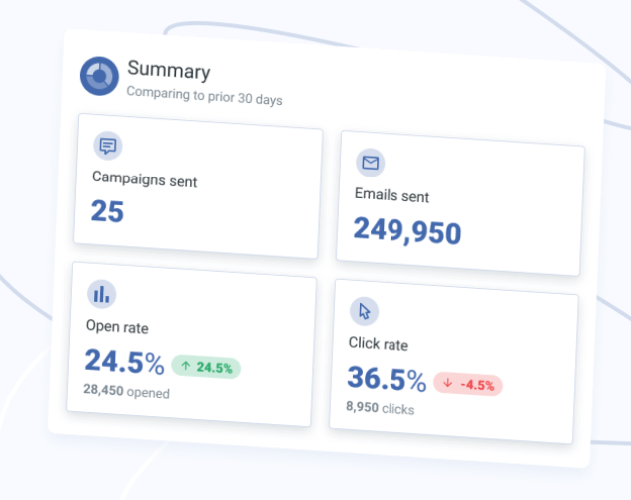- Home
- Email Marketing
- Learn
- 8 Email Marketing Metrics You Should Always Track
8 Email Marketing Metrics You Should Always Track
As a result, email marketing has become essential for many marketers in various industries, locations, and business sizes. Though every campaign is different, the goal is typically the same – increase the company’s conversions by sending informative emails to customers on a regular basis.
You may think sending the email is the most important part of your campaign, but tracking and analyzing the success and progression of your emails is just as important.
WebFX has a team of 500+ experts who can help you organize and put together an email marketing campaign most effective for your business. You can call 888-601-5359 or contact us online for help getting started today!
On this page, we’ll talk about why it matters to track your emails, what metrics you should be tracking, and what to do with your results.
Our digital marketing campaigns impact the metrics that improve your bottom line.
See Our Approach
$10 billion

24 million

7.14 million
Why tracking and analyzing emails matters
Sending emails without tracking and analyzing them is – simply put – a waste of your efforts.
Without measuring your results, you’re essentially putting in a lot of work without knowing exactly how your campaign is performing. Sure, you could see a spike in sales and assume that it’s due to your new monthly newsletter, but in order to truly understand your audience and the way they behave, you should track your emails.
One of the most important reasons for tracking is to understand your audience.
When you first create your email marketing campaign, the only knowledge that you start with is the email addresses of subscribers, and the fact that they are interested in something that your company offers.
Tracking and analyzing your sent emails allows you to put together the pieces and form a more complete profile of your users – which is a huge benefit.
It would be similar to trying to fish for a certain kind of fish, but not knowing what kind of bait they’re most attracted to.
When you form a better-rounded customer profile, you can cater and craft your emails to what customers like, what they’re interested in, and how they respond to each element of your emails.
For example, maybe for your industry, coupons are an email element that works especially well in attracting customers to your store. Maybe your customers respond better to a shorter subject line rather than a longer one.
All of these elements can be made to cater to the user after you’ve tracked and analyzed your emails.
Metrics you should be tracking
Tracking and analyzing your emails is an important part of your campaign. But you may be wondering – what is there to track?
There are a ton of elements that you can track using email analytics platforms. All of the ones we’ll talk about are important to understanding your customer base and catering specifically to them.
Subscriber list growth
Definition: The number of new users who sign up for your email list
First, you should pay attention to how well your email subscriber list is growing. Most lists have a natural decay rate, which is why you constantly need new subscribers. If your email list is slowly losing steam, it’s time to push some new strategies that will get you more subscribers.
Email marketing is one of the most valuable resources a company can use to reach potential clients or followers. If you’re going to use it to your advantage, you need to cast a wide net. You need subscribers.
Open rate
Definition: The percentage of people who open any given email.
Email open rate is calculated by dividing emails opened by the number of emails you sent minus the emails that “bounced,” or couldn’t be delivered.

Open rate is an important metric to track because it lets you know how many recipients are actually opening your emails, and therefore, how many people are actually seeing the information you share.

On average, open rate is between 20-40%.
The graphic outlines just a few of the industries that fall in this open rate category. The ones near the top of each list are more toward the high end of open rate percentage and the ones toward the bottom are on the lower end.
If your open-rate seems a little low, there are a few things that you could test.
It may mean that you should try a different subject line, since that’s the part of an email that users see before opening it. For example, if your subject line is just one word, you could try something a little longer. If it was typed in all lowercase letters, test the difference in open rate after changing it to sentence case, or capitalizing the first letter of each word.
Open day and time
Definition: The date, day of the week, and time subscribers open your emails
You sent your email out on Monday at noon, but the majority of recipients didn’t open it until Tuesday at 9 a.m. Could your campaign benefit from sending emails just before peak hours? There’s only one way to find out! Measure click-to-open rate (CTOR)!
By adjusting the time you send your email blasts, newsletters, coupons, or other information, you can potentially increase clicks and reads on your emails. If you consistently see that most of your emails are being opened at a certain time of day, you might as well try to match the campaign’s behavior to your recipients’ behavior and see if your campaign improves.
Click-through rate
Definition: Click-through rate, or CTR, refers to how many people click on any links that are included in your emails.
You can calculate your open rate by taking the total clicks, divided by the number of delivered emails and multiplying the answer by 100. This will give you a CTR percentage.

Click-through rate is one of the most important metrics to track with your email marketing campaigns.
The point of an email campaign is to get more people to visit your website, learn about your products or services, and eventually convert – and determining how many people click the links in your emails is essential for understanding how well you’re achieving your goals.
If your links aren’t being clicked, they’re not serving their purpose – and most importantly, they’re not helping to drive traffic to your website.
Conversion rate
Definition: The percentage of email recipients who completed a desired goal action.
You can calculate conversion rate by dividing the number of people who completed your goal action by the total number of emails that were delivered, and multiplying the answer by 100.

Conversion rates will be different for every campaign. That’s because as a marketer, you choose what is deemed a conversion.
Some of the things marketers consider conversions are filling out a contact form, making a purchase, downloading a guide, or entering a contest.
All of these things are worthy of being considered a conversion because they essentially all move interested customers further down the sales funnel.
Each of them are important conversions, and but it’s up to you which ones you use to measure the success of your email marketing campaigns. Here are a few examples of conversions:
Filling out a contact form
One of the most popular conversion goals for marketers is getting users to fill out a contact form.
Let’s say that as a part of your email newsletter, you include a link taking users to a page where they can learn about a specific service, and potentially ask for more information if they’re interested.
If users click a link in your email, make it to your website, and fill out a contact form to speak with someone at your company about a service, that can most definitely be considered a conversion.
If a user is willing to ask for more information, they are making their way down the sales funnel and moving closer to making a purchase.
You should use filling out a contact form as a conversion goal if you sell products or services that require potential customers to get in contact with a member of your sales team.
For example, you might be less likely to consider contact forms as a conversion if the forms simply encourage users to “fill out the form if you’re interested in receiving our monthly mailer.”
However, if your contact forms are something like “fill out the form if you’d like a custom quote on this package,” they’re more likely to play a major role in your sales process. If someone is looking for a quote, they are truly interested in your product or service.
Making a purchase
When most people think about the word conversion, the first thing that comes to mind is an actual sale.
Considering sales as a conversion is the best way to calculate ROI, since purchases are the only real way to calculate your return versus your investment.
Sales are also the truest form of conversion, since the overall goal of an email marketing campaign is to get users to purchase your product.
Tracking purchases as a conversion is a great idea for any company. That being said, it shouldn’t be your only conversion goal – because leaving out other, smaller conversions can give you the impression that your campaigns aren’t achieving results.
Downloading a guide
Downloading a guide or other content can also be considered a conversion if you link to something on your site that users can download to their devices.
For example, if you are a gardening company, and you send a newsletter with an attached guide on how to ensure your crops come up this year, the main goal of that email is to get users to download the guide.
Throughout the guide, you can throw in specific calls-to-action that encourage users to check out your products. You could include tips on how to prepare your soil, and include a link to a product page selling fertilizer or a specific shovel.
In this case, the download acts as a conversion because the main goal of that specific email was to have the recipient download the guide. And within it, there are even more options to draw customers to your website and make a purchase.
Entering a contest
You could also consider users entering a contest you’re holding as a conversion – especially if entering encourages users to do something for your company.
For example, you can advertise a contest that users can enter by sharing a picture of themselves with your product. Even though they aren’t necessarily buying your product (yet), you can consider this a goal conversion because you will be getting a ton of free user-generated content.
Not to mention, if the user wins the contest, they’ll be more likely to become a repeat customer – because they know you treat your patrons well.
No matter what you decide to consider a conversion, make sure you set up your goals correctly in your email marketing platform so that you can track all the right things and get the correct information.
Bounce rate
Definition: The number of emails that were sent to recipients, but could not successfully be delivered to their inboxes.
You can calculate email bounce rate by dividing the total number of bounced emails by the number of emails you sent, and multiplying the answer by 100. This will give you a bounce rate percentage.

Before getting into why bounce rate is important to track, it’s important to understand the two different kinds of bounces – hard and soft.
Soft bounces are emails that don’t go through because of a problem that is temporary. This could mean the recipient has a full inbox, or there is an issue with the recipient’s server.
If there is a server issue, it’s possible that your email will eventually go through, but otherwise, you’ll just be able to resend it later.
Hard bounces are when there is no chance that the email will ever get to the recipient. It could be caused by sending an email to an invalid email address, or an address that’s been closed.
You want to track your bounce rate because it lets you know how many recipients are actually getting the information that you send. In addition, you want to keep an eye on which email addresses are bouncing so that you don’t continue to send emails to that address.
If you do, your sender reputation could decrease, since bounce rate is one of the most important factors in determining your reputation.
Unsubscribes
Definition: The number of people who opt out of your emails in any given campaign.
Your unsubscribe rate is usually expressed as a percentage, which tells how many people out of every 100 clicked the unsubscribe button. For example, if your unsubscribe rate is 5%, that means that 5 out of every 100 recipients unsubscribed.

It’s important to track your unsubscribes because they can tell you a lot about your email campaign, as well as individual emails.
If you notice a sudden increase in unsubscribes, and you also know that you just made a big change to your email template or subject line style, it could be a sign that the change isn’t working.
And if you haven’t made a recent change with your emails, unsubscribes could tell you that it’s time to make one.
No matter what, if you have a high unsubscribe rate, it’s an indication that something with your email marketing campaign needs to change.
Spam complaints
Definition: When users flag your email as spam.
Many email tracking programs allow you to see how many users flag your email as being spam. It’s important to track this because if it happens too many times, Gmail might see your sender reputation as negative.
If that happens, even subscribers that haven’t marked your emails as spam may not receive your emails, which can impact your email deliverability rate.
How to use analytics to improve your email marketing
Now that you understand exactly what metrics you should be checking into and tracking regularly, it’s time to talk about how to test different elements of your emails in order to increase open and click-through rates and decrease things like bounce rate.
A/B testing
A/B testing is one of the best ways to understand how users interact with your emails. It allows you to change small details about your emails, send them to different groups of recipients, and see how each group reacts to each version.
You can collect information that allows you to choose the best possible variations of your links, buttons, templates, and even subject lines – which can all lead to higher conversion rates.
There are a few elements of your emails that you shouldn’t forget to test.
Different subject lines
Subject lines are important to your email marketing campaigns, because they are the first thing that recipients will see.
They dictate whether a user will choose to open the email, can intrigue them to learn more, or can scare them away – all within a matter of seconds.
It’s important to test different kinds of subject lines so that you can understand exactly what your recipients are enticed by, and what could be making them delete an email before they even open it.
Test things like the length of your subject line, different capitalization combinations, and tone.
Different CTAs
Placing calls-to-action in your emails is one of the best ways to get users to complete the goal that you want for your campaign.
You could include a CTA that tells users to visit your website for a full list of products, or you could use one to encourage them to download your free guide (which also has its own set of CTAs inside).
If you use CTAs in the form of buttons, you can test things such as button text, button color, and button size to narrow down the most effective CTA for each email.
Including testimonials
Including testimonials is something that you should definitely test within your emails.
Testimonials are a proven method of building trust in your target audience because they are social proof that other people, just like them, love and trust your product. There’s no better way to show that you create satisfied customers than by referencing them in your emails.
When you test the inclusion of testimonials, you’ll be able to determine whether they work better as text, video, or photos with text.
You can also test whether they get a better reaction above or below the fold of the email.
Personalization
Personalizing your emails can increase your click-through rates and make users feel like you’re speaking to them as an individual, not just part of a group of subscribers. 94% of businesses believe that the personalization of emails is crucial to their current and future success.
You can run tests that determine if personalization works best in the subject line, the opening of the email, or both.
The goal of personalizing your emails is to let them know that you care about their individual contribution to your company, and it can have a major impact on whether they ultimately decide to convert.
Email tracking tools
Now that we’ve talked about the metrics you should track within your email marketing campaigns, and what elements you should test to ensure that you have the most engaging emails possible, let’s talk about some of the tools you can use to track and test.
EmailMarketingFX
EmailMarketingFX, WebFX’s proprietary email marketing platform and part of RevenueCloudFX, allows our clients to track many things within their email campaigns.
The program can show who your most interested subscribers are by showing how many times your email was opened, when, and by whom. You’ll also be able to see a minute-by-minute account of who’s opening your emails.

We provide each of our clients with a report of their link activity, which makes it easy to see what links are working the best in their emails. In addition, they have access to reports on who opened, who clicked, who bounced, and who unsubscribed – all important metrics that we mentioned earlier!
MailChimp
MailChimp is a free email marketing platform that provides unique insights into how users interact with email content.

Users can see the click rate in each email, how many recipients clicked on links, clicks per unique opens, total clicks, top links clicked, and more.
They can also see how many recipients opened the email, bounce rate, and more.
Campaign Monitor
Campaign Monitor is a paid program that allows marketers to gain powerful insight into how their emails are performing.

It allows users to see who opened their emails and at what time, how many times the email was viewed by the recipient, who forwarded each email, what emails bounce, and what exactly users are clicking on within the emails.
Users can also connect Campaign Monitor with analytics platforms to see even more in-depth metrics.
Do you need help starting an email marketing campaign?
Email marketing can be a challenging task, especially if you don’t have the time or experience to create a campaign that will work.
At WebFX, we can help your company create an email marketing campaign that will turn site visitors into subscribers, and subscribers into paying customers. We’ll also provide in-depth reports on key metrics for each campaign, and use that information to continuously improve your results.
Contact us today for more information and a free quote!
Marketing Tips for Niche Industries
- 6 Stellar Benefits of Email Marketing for Solar Companies
- 7 Email Marketing Ideas for Nonprofits
- 7 Keys to Successful Veterinarian Email Marketing
- 7 Steps to Email Marketing for Luxury Brands
- Email Marketing for Chiropractors
- Email Marketing for Chiropractors
- Email Marketing for Churches: 9 Tips for Better Emails
- Email Marketing for Doctors & Medical Practices
- Email Marketing for Doctors & Medical Practices
- Healthcare Email Marketing: 5 Strategies for Hospitals











